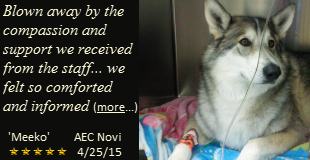
All pet owners should be aware of the potential toxiticy of essential oil products.
Essential oil toxicosis in veterinary patients can vary depending on the oil content. Symptoms range from mild gastrointestinal upset or vomiting, diarrhea and anorexia to neurologic signs involving ataxia or disorientation, seizures, coma and even death. Cats appear to be more sensitive to ingestion, resulting in more severe side effects. Information regarding toxicity is still ongoing, and is a fairly new research area. It is typically not recommended to induce vomiting as the oils are rapidly absorbed once ingested.
If you are a pet owner and also use essential oils, please be aware there are risks for your pet. We do not recommend that any essential oils ever be given to your pet, and if you use them yourself, please be aware that some oils may contain components that could be toxic to your pet whether ingested or absorbed through the skin. Vaporized essential oils could also potentially expose your pet to a toxic substance. Essential oils can be found in insecticides, aromatherapies, personal care products, flavorings, herbal remedies and liquid potpourri. There is a wide variety of products and potential scenarios for unintended use.
Many pet owners are confused about essential oils because they see conflicting information about them relative to pets. Essential oils are becoming more and more popular. Many people do use essential oils for themselves and are happy with results and share those experiences with others. Some people use them around or with pets under very specific conditions. When people see that some pet products may contain trace amounts of essential oils, or see that some people even sell essential oils for pets, there is often a generalization formed that essential oils must be good for pets. Sometimes people would rather choose to believe that a certain product is completely harmless rather than take the time to understand what is being communicated. The simple reality is that reactions depend on a combination of factors and there are no hard and fast rules.
Some EO users make blanket statements such as "essential oils are safe as long as you use a high quality product such as ____________" or "you just can't use cheap internet oils" or "the product needs to be 100% pure" or "you just have to dilute the oil". �Some people may want to hear a simple message like that, but none of these statements provide enough context or information for a concerned pet owner. Frustrating, isn't it?
With essential oils, our message is one of caution. Over the counter products can vary widely on concentration. With any toxicities in pets, you must first assess the ingredient: How much of what substance(s) are we talking about? In the case of essential oils, it is especially important to know the base concentration of the product. If you diluted the product, by how much? Next, you need to identify the mode of transmission: Was the item ingested, inhaled and/or absorbed through the skin? Over what period of time? Did you administer the product or was this a situation where your pet accidentally got into the product? What amount of the product may they have been exposed to? How long has it been since they were exposed or started having noticeable symptoms? Lastly, what type of pet are we talking about? What species and breed? How much does it weigh? How old is the pet? What is it's general health? Is it on any medications?
All these considerations play a role in determining toxicity. For those EO users who are stuck on thinking "my brand won't do any harm" you are missing the point. For example, it doesn't matter that brand (A) "Tea Tree" oil is sold in bulk on the internet while brand (B) "Tea Tree" oil is made from the finest ingredients or is only available through a reseller... the takeaway is that the essential oil products we identify here can definitely harm your pet if they ingest or absorb too much of that product. �If you have a cat, they are much more sensitive because of their inability to metabolize certain substances. In cats these oils are rapidly absorbed orally and through the skin, and then metabolized by the liver. �Since cats lack some liver metabolic pathways, they can have difficulty eliminating these compounds. �Cats are also very sensitive to phenols and phenolic compounds. If you have a bird or reptile or other exotic animal, they are also likely to have an adverse reaction.
An essential oil product that is 100% pure and intended to be diffused is actually going to be much more potent to a pet if exposed than a product that has a lot of filler ingredients. When a product is diluted it is obviously less impactful, but there are no standardized guidelines for pets. When a product is diffused, yes, of course that is less impactful than being ingested, but remember that most pets have a much better sniffer than you do and what may seem pleasant to you may be overwhelming for them. If you are diffusing an ingredient known to be toxic, what will the long term impact be? Are you diffusing that product in a closed space? What is the ventilation like in your home? What type of diffuser are you talking about?
Passive diffusers such as reed, heat diffusers (plug-ins, candle burners, table top warmers), personal evaporative diffusers (necklace pendants, bracelets) and motorized diffusers (use a fan) all evaporate the oil. �The concern with these types of diffusers is that the oil could cause respiratory irritation - and there is also always the possibility that the oil used could get on the pet's skin or be ingested if the diffuser is tipped or tampered with. �With active diffusers (nebulizers, ultrasonic) the actual microdroplets or particles of oil are emitted into the air. The concern here is that microdroplets can collect on the pet. Consider a cat that is grooming themselves after having microdroplets collect on their fur - if the product is toxic they will shows signs similar to actual ingestion.
There are a lot of unknowns to consider and it is reasonable to question the risk versus benefit. Many essential oil products are labeled with child protective warning labels and in some countries special tamper proof packaging is required for them. Your pet doesn't read instructions or warning labels, doesn't know how to diffuse oils, and is more prone to getting into things they shouldn't than you may realize (until something bad happens). Read the fine print on all these products.
The following list of essential oils are known to be toxic:
- armoise
- bitter almond
- boldo leaf
- buchu
- calamus
- horseradish
- lanyana
- large wormwood
- mustard
- pennyroyal
- southernwood
- tansy
- thuja
- tree wormwood
- western red cedar
- wormseed
- wormwood
The following essential oils are potentially toxic (dose / exposure dependent). They are typically more sensitive to cats:
- basil
- bay leaf
- birch
- citrus
- cinnamon bark
- clove leaf
- corn mint
- hyssop
- myrrh
- oregano
- peppermint
- pine
- sassafras
- savin
- savory
- tarragon
- tea tree
- wintergreen
- ylang ylang
Some of these dose dependent oils listed are used in pet products, but in very low concentrations.
Melaleuca (tea tree) oil contains terpenes, sequiterpenes and hydrocarbons and is found in products such as shampoos and flea products for multiple species. �Clinical signs may develop up to 12 hours after exposure and include hypothermia, ataxia, dehydration, nervousness, trembling, paralysis, CNS depression (coma) and fatalities. Increased liver enzyme levels may be observed. Decontamination (bathing) and symptomatic / supportive care usually results in rapid recovery.
Pennyroyal oil may be found in flea products. �Pets can become symptomatic within 1 hour and progress rapidly, becoming listless and can experience vomiting, diarrhea, epistaxis and death. This oil will cause liver necrosis. Wintergreen oil is readily absorbed through the skin. It contains a glycoside which is hydrolyzed and releases methyl salicylate which is toxic to dogs and especially cats. �Clinical signs are depression, anorexia, emesis, gastric hemorrhage, toxic hepatitis, anemia, bone marrow hypoplasia and pyrexia.
Sassafras oil is commonly used to sooth external insect bites and stings and for removing lice. �The main constituent of oil is safrole, which is a carcinogenic!
Citrus oil and some citrus formulations (sometimes found in insecticide formulations for dogs and cats) can cause hypersalivation, muscle tremors, ataxia, CNS depression (coma) and fatalities. Pure citrus oil can be fatal especially in cats. Cats are also sensitive to lavender and thyme oil.
Camphor oil is often used to relieve pain and reduce itching in humans. It is rapidly absorbed from the skin or if ingested and will have toxic effects within minutes of exposure. Symptoms include vomiting, abdominal pain, excitement, tremors, seizures, CNS depression (apnea, coma) and fatalities.









